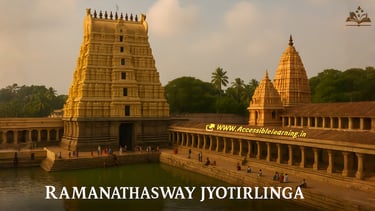
Ramanathaswamy Jyotirlinga: A Sacred Abode of Shiv Ji!
Located in the coastal town of Rameswaram in Tamil Nadu, the Ramanathaswamy Jyotirlinga (रामनाथस्वामी ज्योतिर्लिंग) is one of the most revered temples in Hinduism. Being one of the 12 Jyotirlingas, it holds a special place in the hearts of devotees of Lord Shiva. This article talks about the rich history, spiritual significance, and architectural marvels of the Ramanathaswamy Temple, making it a must-visit pilgrimage site for spiritual seekers and tourists.
TRAVEL LIFESTORY/ENTERTAINMENTINDIA/BHARAT
Sachin K Chaurasiya
7/28/20254 min read


Nestled on the serene island of Rameswaram (रामेश्वरम्) in Tamil Nadu, the Ramanathaswamy Jyotirlinga (रामनाथस्वामी ज्योतिर्लिंग) is not just a temple—it’s a spiritual experience that connects you deeply with the divine. As one of the 12 sacred Jyotirlingas, this temple holds a special place in the hearts of Shiv Ji devotees and stands as a beacon of faith, history, and culture.
The Story That Connects Ramanathaswamy to the Ramayana (रामायण)
The legend of Ramanathaswamy Jyotirlinga (रामनाथस्वामी ज्योतिर्लिंग) is as captivating as the temple itself. It takes us back to the time of the Ramayana (रामायणम्), an epic that has shaped much of Hindu tradition. After defeating the demon king Ravana (रावण) in Lanka (Sri Lanka), Shri Ram Ji (श्रीराम जी) was troubled by the thought of having killed a Brahmin (ब्राह्मण), as Ravana was one. To atone for this, he sought to worship Shiv Ji (शिव जी) and decided to establish a lingam on the sacred land of Rameswaram.
Ram Ji sent his devoted companion, Hanuman Ji, to fetch a lingam from the Himalayas. But as time ticked away and Hanuman Ji didn’t return, Mata Sita (माता सीता), Ram Ji’s devoted wife, created a small lingam out of sand (रेत). Shri Ram Ji, eager to complete the ritual, consecrated this lingam, which became known as the Ramalingam.
When Hanuman Ji's finally arrived with the Himalayan (हिमालय) lingam, Shri Ram Ji also consecrated it, and this lingam came to be known as the Viswalingam (विश्वलिंगम्). Out of respect for Hanuman’s efforts, Shri Ram Ji decreed that devotees should first worship the Viswalingam before offering prayers to the Ramalingam—a practice that continues to this day.


Why is it so important?
A Sacred Jyotirlinga (एक पवित्र ज्योतिर्लिंग)
Ramanathaswamy Jyotirlinga is one of the 12 Jyotirlingas—places where Shiv Ji is believed to have manifested as a powerful column of light. These are not just temples; they are the epicenters of divine energy, where devotees feel an unshakeable connection (अटूट संबंध) to Shiv Ji.
A Deep Connection to the Ramayana (रामायण से गहरा संबंध!)
The temple’s ties to the Ramayana give it an added layer of spiritual significance. It’s a place where the divine grace of Shiv Ji meets the devotion of Ram Ji, teaching us about duty, humility, and the power of faith.
A Pillar of the Char Dham Pilgrimage (चार धाम तीर्थ यात्रा का एक स्तंभ!)
Rameswaram is one of the four sacred sites of the Char Dham Yatra (चार धाम यात्रा)—a journey that devout Hindus undertake to attain spiritual liberation. Along with Badrinath, Dwarka, and Puri, Rameswaram holds the promise of moksha, making it a pilgrimage destination that many aspire to complete.
The Architectural Marvels That Take Your Breath Away
Majestic Gopurams (राजसी गोपुरम)
As you approach the Ramanathaswamy Temple, the first thing you notice are the huge gopurams (विशाल गोपुरम)—the monumental gateways to the temple. The eastern gopuram, which stands 53 meters tall, is an architectural wonder, adorned with intricate carvings that tell stories of gods, goddesses, and mythical creatures.
The World’s Longest Temple Corridor (दुनिया का सबसे लंबा मंदिर गलियारा)
Walking through the corridors of the temple is an experience in and of itself. Stretching over 1,200 metres and supported by 1,212 pillars, it is the longest corridor of any Hindu temple in the world. As you walk through, the carvings on each pillar seem to tell stories from the past, and the sheer size of the structure leaves you in awe of the craftsmanship.
Sacred Theerthams (पवित्र तीर्थ)
The temple complex has 22 tirtha (tanks of holy water), where pilgrims take a holy dip before entering the temple. Each tirtha has its own legend and is believed to have unique healing properties. Bathing in these waters is considered an essential part of the pilgrimage, a way to purify both the body and the soul.

Plan to visit! (Travel Guidelines)
Best Time to Visit
October to April offers pleasant weather and vibrant temple activities. Visiting during Maha Shivaratri is especially rewarding, with grand celebrations.
Dress Code
Men should wear dhotis, and women are encouraged to wear sarees or salwar kameez to respect the temple’s sacredness.
Accommodation and Transportation
There are many options for accommodation in Rameswaram, from simple lodges to more comfortable hotels, suitable for every type of visitor. The town is well connected by road and rail, with regular trains running to Rameswaram Railway Station. The nearest airport is in Madurai, about 170 km away, from which you can easily reach Rameswaram by bus or taxi.
Best Place for you
Dhanushkodi: Distance from Ramanathaswamy Temple: Approximately 20 km. Why visit there?!
Scenic Beauty: Dhanushkodi is a stunning stretch of land where the Bay of Bengal meets the Indian Ocean. The pristine beaches, with their soft sands and clear blue waters, offer a tranquil escape.
Historical Significance: Once a bustling town, Dhanushkodi was destroyed by a cyclone in 1964, leaving behind an intriguing ghost town. The remnants of churches, railway stations, and homes offer a glimpse into the town's past.
Spiritual Importance: Dhanushkodi is believed to be the place where Ram Ji built the bridge (Ram Setu or Adam’s Bridge) to Lanka (Sri Lanka). This makes it a spiritually significant site for devotees.
Adventure and Photography: The drive to Dhanushkodi is an adventure in itself, with the narrow strip of land surrounded by water on both sides. It’s a paradise for photographers, offering stunning sunrise and sunset views.
What to Do in Dhanushkodi!?
Explore the Ruins: Wander through the ruins of Dhanushkodi and feel the history that still lingers in the air.
Visit Arichal Munai: This is the land's end at Dhanushkodi, where you can see the meeting point of the two seas.
Relax on the Beach: Spend some time on the serene beaches, enjoying the sound of the waves and the peaceful environment.
Travel Tip
Best time to visit: Early morning or late afternoon is ideal to avoid the afternoon heat and enjoy the beautiful light for photography.
Getting there: You can reach Dhanushkodi by local jeep or taxi from Rameswaram, as the road leading to it is narrow and requires skilled driving.
The Spiritual and Cultural Impact
The Ramanathaswamy Temple is not just a place of worship; it is a living legacy of South India's spiritual and cultural heritage. Whether you are drawn by the powerful legends, the stunning architecture, or the promise of spiritual peace, a visit here is a journey into the heart of the Hindu tradition. The temple is a place where mythology comes alive and where every step you take takes you closer to divinity.
So, whether you are a devout pilgrim or a curious traveler, Ramanathaswamy Jyotirlinga offers an experience that resonates on both spiritual and cultural levels. It is a place where the past and the present come together, inviting you to be a part of a story that is thousands of years old.
Subscribe To Our Newsletter
All © Copyright reserved by Accessible-Learning Hub
| Terms & Conditions
Knowledge is power. Learn with Us. 📚


